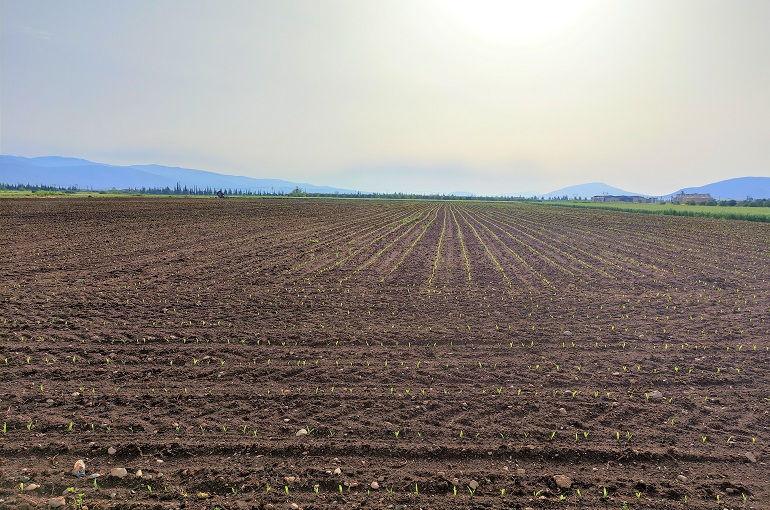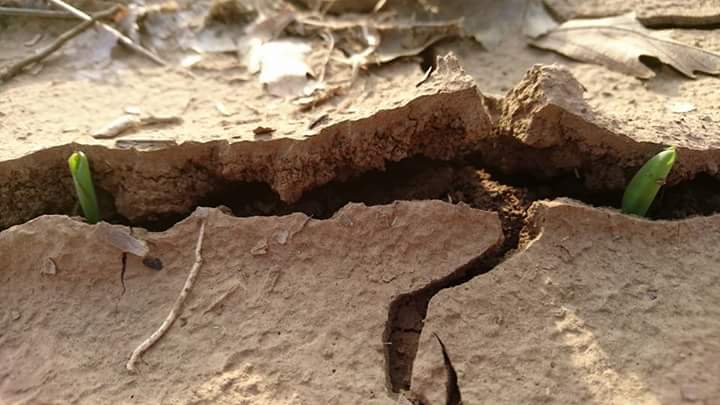Maize Soil preparation, Soil requirements and Seeding requirements

This post is also available in:
This post is also available in:
![]() Español (Spanish)
Español (Spanish) ![]() Français (French)
Français (French) ![]() Deutsch (German)
Deutsch (German) ![]() Nederlands (Dutch)
Nederlands (Dutch) ![]() हिन्दी (Hindi)
हिन्दी (Hindi) ![]() العربية (Arabic)
العربية (Arabic) ![]() Türkçe (Turkish)
Türkçe (Turkish) ![]() 简体中文 (Chinese (Simplified))
简体中文 (Chinese (Simplified)) ![]() Ελληνικά (Greek)
Ελληνικά (Greek) ![]() Português (Portuguese (Brazil))
Português (Portuguese (Brazil)) ![]() polski (Polish)
polski (Polish)
Corn needs loose soils that offer proper aeration and drainage and at the same time maintain sufficient amounts of water close to roots. Too heavy or too sandy and poorly drained soils are not suitable. In general, the plant prefers pH levels higher than 5,5. More specifically, the optimum pH for corn is between 5,8 and 6,8. Having pH levels close to 5, may reduce the production up to 35%. Corn is slightly sensitive to increased salinity levels.
After selecting and testing the maize variety, farmers need to prepare their field for sowing. The appropriate seedbed preparation can dramatically affect germination, emergence-establishment of the crop, and of course crop growth, leading to higher final yields.
Seedbed preparation for corn
In conventional tillage systems, farmers apply 1-3 soil tillage sessions. It is highly advised that the farmers adopt a rounded approach and avoid unnecessary tillage that will harm soil structure and lead to soil compaction. Apart from conventional tillage, the farmer can implement stubble-mulch, reduced or no-tillage. All four systems have advantages and disadvantages, and the farmer should consider them carefully before choosing which plan best fits the field’s unique characteristics (1).
Tillage aims to create a loose and crumbly soil surface and consists of the primary (mechanical) weed management technique. The soil preparation starts much earlier than the actual sowing of corn seeds. From the previous crop’s harvest, farmers often chop and evenly spread crop residues on the field surface. The residue management can play an essential role in maintaining-improving soil texture-moisture and reducing disease and insect problems (Gentry et al., 2013). It is necessary to implement some weed control measures before sowing corn, in order to minimize the competition of the crop with the weeds for sunlight, space, water, and nutrients.
In organic cultivation systems, where chemical herbicides cannot be applied, maize farmers should take extra care while choosing the most appropriate time to enter their field to perform tillage. In this case, most farmers choose to intervene twice, once after the first weeds have started growing and once a bit later (around 2-3 weeks) to “catch” the second round of weeds (usually less than a week before they sow)(3).
- The primary (first and basic) tillage
It takes place earlier in the season, usually after the harvest of the previous crop (or 1-2 months before sowing the corn) (4). At that time, the farmer can incorporate some compost into the field. Early plowing should be avoided in areas with a slope greater than 8% since it will contribute to soil erosion due to winter rainfalls and strong winds.
Tilling during early spring serves as a very efficient weed control measure. At the same time, it contributes to the removal of excess water from the soil, improves soil aeration, and promotes the warming of the seedbed. If the farmer has a cover crop like alfalfa on the field, he/she can incorporate the plants into the soil with the first tillage.
Depending on the soil texture, the farmer may need the following equipment for the primary tillage:
- Moldboards plows (better to be avoided in sandy soils)
- Disc plows (useful on dry-hard soils, not recommended for sandy soils)
- Chisel plows (better results in relatively dried soils)
- Rippers (to break the formed plow-sole)

- The secondary tillage.
It is usually performed a few days before sowing the crop. Farmers can use:
- Tined cultivators (for weed seedling and breaking soil crust, some soil moisture is needed to be effective)
- Harrows- Disc Harrows (to break clods and soil crust)
In dry, sandy soils, farmers should be cautious not to destroy the soil structure, and they should avoid passing the field too many times with the machinery and disturbing the soil.
Organic farmers might choose to make one more tillage right before sowing. If the weather is warm enough, they might decide to sow right after the second tillage. Extra tillage might be necessary if there is a rainfall too close to the sowing day since in this case, the weeds will germinate much faster than maize and will “drown” the young seedlings (2).
Under no-tillage systems, with crop residues from the previous crop remaining on the soil surface, the preparation is limited to one-pass planting and fertilizer operation to limit the disturbance of the soil surface. In this case, the farmer will need to create a 2-3 cm wide strip or open small holes into the ground to place the corn seeds (Karki, 2014). The use of No-tillage planters might be needed for better results.
Factors to consider when selecting the sowing date for maize
- Since maize is a warm-climate crop, the mean daily temperature needs to be above 15 °C (59 F) to grow. While there is variability among the commercial maize varieties depending on the adaptability at different temperatures, the maize seeds, as a general rule, can germinate when the temperature is above 8-10 °C, and the spring frosts have passed. Keep in mind that maize seedlings are very sensitive to frost. The germination is faster and more uniform at higher soil temperatures (16-18 °C) (1). This is why organic farmers generally choose to sow a bit later (faster corn plant emergence gives a head start to the crop against weeds). Apart from the minimum temperature for seed germination, the farmer should take into account other factors for selecting the most appropriate sowing date for his/her crop.
- In no-tillage systems, the sowing takes place one week later compared to fields where conventional tillage systems are followed. This happens because the soil temperature at 4-6 cm (2-inch) depth is usually cooler (Karki, 2014).
- Maize is susceptible to high temperatures and drought stress during the fertilization of the inflorescence and the maturity of the grains. To avoid high temperatures risks (32°C – 45 °C), such as yield decrease, the farmer can select early maturing varieties (with a shorter life cycle) or move, if possible, the planting day a bit earlier.
- Generally, late sowing will lead to a yield decrease. This happens because the maize plants do not have the needed time (growing degree units or GDU) to reach maturation before the first autumn frost. The problem is even larger in late maturing maize varieties. When the temperature is at an optimum level (above 20°C ) during the growing season, maize plants will reach maturity faster. Maize grown as a forage crop does not have such strict demands for temperature.
- The sowing of maize should occur when the soil moisture content is at the optimum level, below the field capacity, usually 2-3 days after a rainfall (3). Of course, this period also depends on the soil structure. The farmer can enter the field with machines and start sowing when the top 4 inches (10 cm) of the soil is dry (iGrow corn) (2). Farmers shall avoid sowing when the soil is too wet since this will contribute to soil compaction and negatively affect seed germination and emergence.
Use certified corn seeds.
The seed used should always be certified. In this case, the farmer can be certain for some important attributes of the maize seeds:
- Uniformity and germination rate (>85%)
The grand majority of seeds germinate at the same time, which means that all plants will grow at the same pass, leading to a dense crop, with a good weed competitive ability and a ”fixed” harvest day.
- Purity, in terms of variety (98%), Clean seeds (no foreign matter), and Healthy seeds (free from any diseases and insect damages).
Number of corn seeds sown per hectare – Maize Plant Population
The number of seeds that the farmers will sow per hectare should generally reflect the final desired plant population they want to have, and it depends on:
- The variety
Based on FAO data, the plant population varies from 20,000 to 30,000 plants per hectare for late varieties to 50,000 to 80,000 or more for early varieties (5). Other data suggest that varieties with long life cycle (700 FAO or more) often have an average optimum number of plants close to 70.000-75.000 plants per hectare, while very early varieties with FAO 200 or less can be planted at 90.000-110.000 plants per hectare.
- The spacing
Spacing between rows varies between 0.6 and 1 m.
- The end-use of the maize
Generally, when corn is cultivated for livestock feed (forage), the plant population is higher (usually by 50%)
- The existence or not of irrigation (sufficient amounts of water)
In irrigated fields, farmers usually sow more plants per land unit.
A higher than normal number of plants per hectare may result in the development of tall plants because they seek access to sunlight. The plants start to lean because the stem is incapable of supporting them. Besides, the water and fertilization requirements increase, and the final protein content of the grain may decrease.
The sowing depth is usually 4 to 7 cm (1.5-2.7 inches). When the soil conditions are favorable or/and rainfall is expected, the seeds can be sown closer to the surface but never in a depth less than 2.5-4 cm. Very shallow or deep sowing will lead to problematic seed emergence and plant establishment (iGrow corn) (2). Finally, in not well-drained, cold soils, farmers can choose to sow in ridges.
It is suggested, if possible, to avoid sowing by hand (spreading the seeds, random seed placement). Uniform spacing between seeds-plants can increase the yield and facilitate weed control even after plants’ emergence (Torres, 2012). Before sowing, the farmer needs to maintain, calibrate and prepare the planter that will be used. Depending on the field area and the farmer’s economic availability, he/she can use either a tractor-driven corn planting machine (pneumatic planter) or a manual seed planter (6). Even though new pneumatic planters can maintain high sowing precision even at higher tractor speeds, it is advised to keep a medium speed for better results.
References
- https://www.arc.agric.za/arc-gci/fact%20sheets%20library/maize%20production.pdf
- https://extension.sdstate.edu/sites/default/files/2019-09/S-0003-13-Corn.pdf
- Seedbed Preparation and Planting – Organic Weed Control – YouTube
- https://www.jica.go.jp/nepal/english/office/others/c8h0vm0000bjww96-att/tm_1.pdf
- https://www.fao.org/land-water/databases-and-software/crop-information/maize/en/
- https://aicrp.icar.gov.in/fim/salient-achievements/sowing-and-planting-equipment/
Karki, T. B., & Shrestha, J. (2014). Maize production under no-tillage system in Nepal. World Journal of Agricultural Research, 2(6A), 13-17.
Gentry, L. F., Ruffo, M. L., & Below, F. E. (2013). Identifying factors controlling the continuous corn yield penalty. Agronomy Journal, 105(2), 295-303.
Torres, G. M. (2012). Precision planting of maize (Zea mays L.). Oklahoma State University.
iGrow Corn: Best Management Practices (pp.6)Chapter: Chapter 13Publisher: South Dakota State UniversityEditors: D.E. Clay, C.G. Carlson, S.A. Clay, E. Byamukama
Fast Facts and History of Maize
Maize Nutritional Value and Health Benefits
Corn Plant Information and Production
How to Grow Corn for Profit – Maize growing guide
Principles for selecting the best maize variety
Maize Soil preparation, Soil requirements and Seeding requirements
Maize Water Requirements and Irrigation Systems
How to successfully control weeds in corn cultivation for higher yields









































































